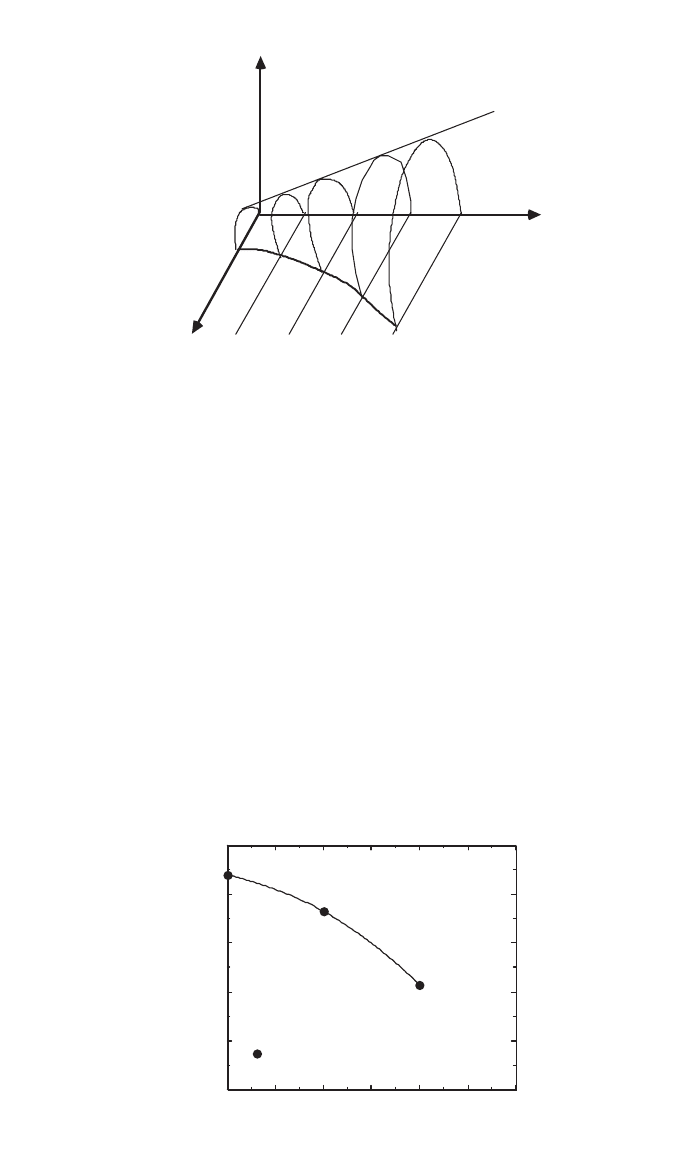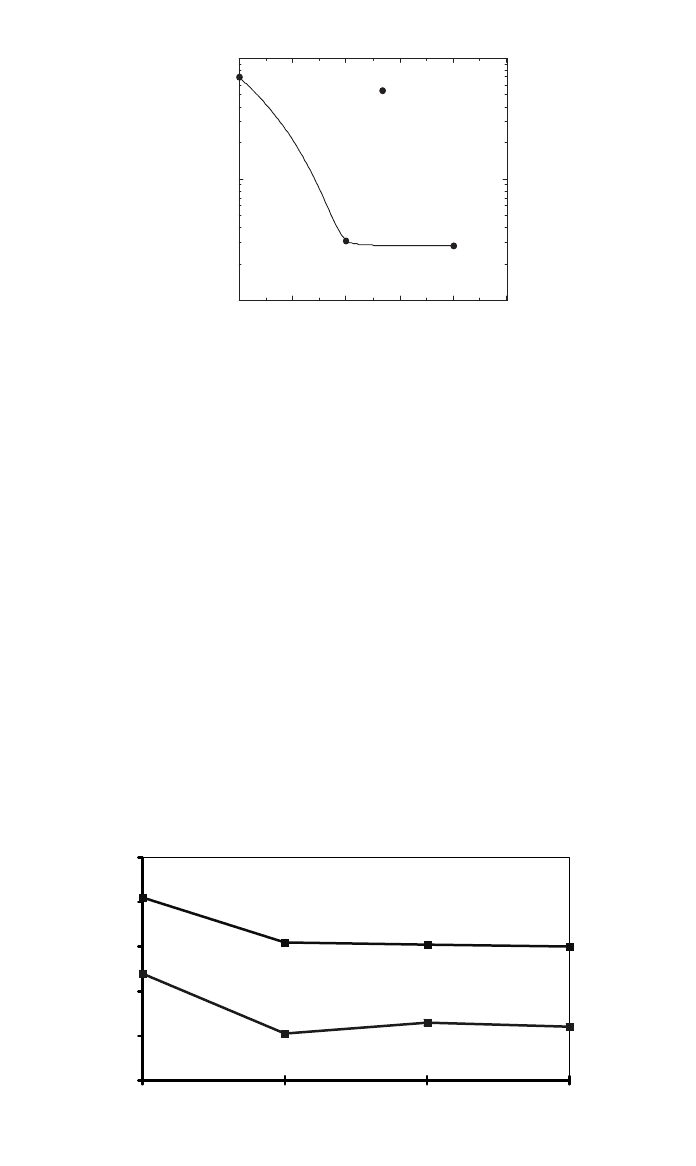Kutz M. Handbook of materials selection
Подождите немного. Документ загружается.


3 PRODUCT DEVELOPMENT FUNDAMENTAL FACTORS 1199
manufacturing. From a business viewpoint, the lowest system cost guideline has
a great impact in determining product design, material selection, and manufac-
turing processes. The lowest system cost can be achieved when the design,
materials, and manufacturing are taken into accounts simultaneously. For ex-
ample, a lowest system cost is still feasible when employing a costly material
that enables to simplify the design and reduce manufacturing cost.
In the managed-care environments, the patient care has been gradually
switched from doctor care to insurance provider care. The cost is extensively
monitored and supervised. Under this great competition, high medical product
quality is expected with no further premium increments. Moreover, home care
also gradually becomes popular. This requires the medical manufacturers to de-
sign ease-of-use medical products for patients with no specific training in the
medical field. The medical design and materials selection can play a critical role
to fulfill the patient expectation, meet product functions, and achieve business
goals.
3 PRODUCT DEVELOPMENT FUNDAMENTAL FACTORS
The key factors that govern the development of medical products can be cate-
gorized into four distinct areas: product design, material selection, manufacturing
process, and product performance.
3,4
The detailed requirements of these four
areas are listed in Table 3. Designing user-friendly products, selecting high-
performance low-cost materials, establishing cost-effective manufacturing pro-
cesses, and validating product quality for safety and efficacy are a must. These
considerations can greatly restrict a manufacturer’s choices for developing a
product.
3.1 Product Design
Medical product design is focused on safety and efficacy. Product design begins
with concept design, design drawing, and stress analysis and ends with the eval-
uation of the prototype. Different design iterations are created and materials are
selected to build prototypes. The prototype is modified after feedback from cli-
nicians, patients, engineers, and manufacturers. The functionality is tested to
confirm the desired efficacy.
For example, to maintain product sterility integrity during shelf life, a closed
system design is required. In addition to product design for safety and efficacy,
the product design also includes device component design such as molding and
assembly, particularly for component joining, welding, and bonding. These de-
signs are typically under the constraints of materials availability, cost of mate-
rials, materials compatibility for joints, manufacturability, sterilization modes,
and product integrity during the shelf life and up to the time of use. Moreover,
marketing always prefers to have features beyond safety and efficacy; good prod-
uct features are usually an excellent vehicle to win patient acceptance.
3.2 Selecting Materials
The process of selecting suitable materials for medical products begins with the
creation of a precise and accurate definition of the product’s material and func-
tional requirements. Finding the right polymers for medical products requires
simultaneous consideration of design, processing, and performance needs.
1
Other
critical factors considered at the material selection stage include biocompatibil-

1200 SELECTING MATERIALS FOR MEDICAL PRODUCTS
Table 3 Medical Product Development Considerations
Product design Safety and efficacy
Product functionality
Ease of use
Product integrity
Design a closed system to ensure sterility integrity
Flexibility for medical product design
Easy assembly
No build-in residual stress in plastic components
Bonding/ assembly capability among product components
Easy quality control by operator vision or instrumental sensor
Sterilize/ form/ fill/ seal
Materials selection Meet requirements of safety, design, processing, and performance
Material compatibility for product components assembly
Drug and solution contact
Biocompatibility and chemically inert
Leachables and oligomer residues
Optical clarity
WVTR, O
2
, and C0
2
barrier
Subambient impact resistance
Material aging, particularly after sterilization
Additive chemicals and catalyst residue
Lot-to-lot consistency from resin supplier
Environment friendliness
Cost
Supplier technical service
Manufacturing processing Extrusion/ molding/ thermoforming capability
Large-scale manufacturability
High production output rate
Wide processing operation window
Compatibility with the plant’s existing manufacturing systems
Assembly technology
Sterilization methods
Product performance Safety, efficacy, and quality
Unique features
Cost/ performance
Function oriented
Market competition
Customer delight
User friendly
Cosmetic appearance
Touching feeling
Odor
ity, leachability, drug–plastic interaction, oxygen and moisture barrier protection,
optical clarity, ultraviolet (UV) stability, shelf life, the end-use environment, and
total system costs. In addition, designers must consider the demands of down-
stream operations such as component bonding, assembly, shipping, storage, and
post-use disposal.
One of the key factors in medical material selections is the sterilization effect
to the material properties. Steam sterilization demands that the melting points
of materials exceed their autoclaving temperatures. Ethylene oxide (ETO) ster-
ilization needs to vent the residual ethylene oxide from the device fluid path to
a minimum level before products can be released. Radiation poses potential
materials degradation that could impact the product performance and also its
extractives might interact with solution drugs or biological agents.

3 PRODUCT DEVELOPMENT FUNDAMENTAL FACTORS 1201
0.40.30.20.10.0
5
6
7
8
OIT (Min)
CaZn Stearate (phr)
OIT (Min)
y = 3.7702 + 32.293x - 74.860x^2
R^2 = 0.935
Fig. 1 PVC OIT dependence on CaZn stearate.
Gamma Radiation Effect on Medical Materials
Gamma sterilization is becoming popular in the medical device and packaging
industry because of convenience and low cost. Concerns of worker exposure to
ethylene oxide and temperature limits of medical materials during high steam
autoclaving have made gamma sterilization more preferable. This mode of ster-
ilization is a consequence of the high-energy electrons released from the inter-
action of the gamma-ray photons with materials. These high-energy electrons in
turn react with the deoxyribonucleic acid (DNA) sequences in the microbiolog-
ical burden in medical devices and drug delivery systems and permanently alter
their chemical structures to render them innocuous.
1
The high-energy electrons, however, can also initiate ionization events in the
material being sterilized. It can create peroxy and hydroperoxy free radicals in
the presence of oxygen and start the degradation cascade. Different materials
degrade via various mechanisms, leading to different modes of failure such as
discoloration, excessive pH shifts and high extractables, and catastrophic fail-
ures. Gamma exposure at 20 and 50 kGy (10 kGy
⫽ 1 Mrad) is usually used
for radiation sterilization. Oxidative induction time (OIT) and yellowness index
(YI) are used to identify a material’s radiation sterilization compatibility. OIT,
a method of thermal analysis measured by differential scanning calorimetry
(DSC),
2,5–8
is used to measure the total stability of a polymer at a given condi-
tion. A more stable plastic has a higher OIT value.
Polyvinyl chloride (PVC) thermal stability, measured as OIT in Fig. 1, has
been reported to exhibit a rather sharp maximum with respect to the concentra-
tion of a primary stabilizer, calcium zinc stearate at about 0.2 phr (part per
hundred) or about 0.13% for the system studied.
5
It was noted that an extremely
linear relationship was found for the secondary stabilizer such as epoxidized oil.
Combined together, Fig. 2 shows the PVC stability function spanning a three-
dimensional design space.
The OIT responses of a PVC formulation at 230
⬚C as a function of the ster-
ilization dose is shown in Fig. 3 with a dose rate of about 6 kGy/h. From the

1202 SELECTING MATERIALS FOR MEDICAL PRODUCTS
Epoxy
CaZn Stearate
OIT
Fig. 2 Three-dimensional schematic of PVC stability.
6050403020100
0
2
4
6
8
10
OIT (230)
Dose ( kGy)
OIT ( 230°C )
Fig. 3 Effect of radiation dose on PVC stability.
zero dose OIT of about 9 min, a steady reduction in total stability was seen. In
addition, the slope (rate of OIT decrease) appeared to increase from 20 to 40
kGy, indicating a nonlinear response accelerating the degradation reaction at
high doses. Figure 3 also indicates that after 40 kGys the formulation loses more
than half of the initial total stability. This will limit the maximum dose this
particular formulation was capable of sustaining.
Radiation also changes polyolefin stability. In a hindered phenol-stabilized
high-density polyethylene (HDPE) film system, the film OIT at 200
⬚C was de-
termined for dose levels of 0, 20, and 40 kGy. Results in Fig. 4 clearly indicated
significant annihilation of the antioxidants during the course of the sterilization.
It was noted that the OIT was nearly flat at 20–40 kGy. This suggests that the
antioxidant in question did not provide additional protection when the radiation
dose was reduced from 40 to 20 kGy.
When Figs. 3 and 4 were compared, PVC was noted to have a slower stability
reduction than HDPE when subjected to radiation. In addition to the inherently

3 PRODUCT DEVELOPMENT FUNDAMENTAL FACTORS 1203
50403020100
1
10
100
200 OIT (min)
Dose (kGy)
OIT (min) 200°C
Fig. 4 Effect of radiation dose on HDPE Stability.
4.8
8.2
6.2
6.1
6
2.4
2.1
2.6
0
2
4
6
8
10
non-sterilized Gamma
Radiation
Gamma,Steam
Autoclave
Gamma,Steam,
Pasteurization
Sterilization
Secondary stabilizer (%) and
OIT (Minutes)
Secondar
y
Stabilize
OIT
Fig. 5 Change of OIT with secondary stabilizer concentration of PVC.
more stable of PVC over PE, it can be also due to the higher concentration of
secondary stabilizer in PVC, which can be about 10%, as shown in Fig. 5. This
may explain why the medical products made from PVC seldom encounter cat-
astrophic failure after radiation.
Figure 5 also shows that radiation sterilization reduced the PVC secondary
stabilizer concentration, as measured by high-pressure liquid chromatography
(HPLC). This in turn reduced material stability as evidenced by OIT. Steriliza-
tion by radiation was noted to deplete more secondary stabilizer than the sub-
sequent steam autoclaving and pasteurization combined.
In contrast, catastrophic failures have been reported during polypropylene
(PP) shelf life storage. Intense investigation came to the following consensus:
5,9–12
The long-lived free radicals trapped in the crystalline domains migrating
toward the crystalline/amorphous interface combining with available oxygen
form peroxy and hydroperoxy radicals that initiated degradation near the inter-
face.
3
As enough tie molecules between crystallites were cut through the chain

1204 SELECTING MATERIALS FOR MEDICAL PRODUCTS
-5
0
5
10
15
20
02550
Radiation Dose (k Gy)
200°C OI
T
Supplier A
Supplier B
Supplie C
Fig. 6 Effect of radiation dose on PP from various supplies.
scission process, significant reduction of PP elongation could occur, which
would lead to catastrophic failures.
Since the stabilizer molecules in PP reside primarily in the amorphous phase,
its effectiveness to react with primary free radicals preferentially is an indication
of the overall postirradiation stability of the material. Accordingly, it is inter-
esting to assess the correlation between OIT and radiation dose based on dif-
ferent suppliers.
Figure 6 shows PP from three different suppliers and their OIT at 200
⬚Cat
0, 25, and 50 kGy of doses. It is clearly seen that supplier A’s formulation,
where the OIT vanishes after only 25 kGy, was not as stable or effective toward
gamma radiation as the other two formulations. On the other hand, although PP
formulations from suppliers B and C had experienced major reduction of OIT,
significant portions remained to protect against further degradations.
Figure 7 plots the OIT from three PP suppliers with the phenolic primary
antioxidant assayed by HPLC. The very good correlation indicated the promise
of using this simple procedure as an early screening tool for evaluating PP
radiation stability. The stability of a radiation-sterilized PP can thus be simply
and very rapidly determined by OIT, and the remaining antioxidant level of
sterilized PP can be easily obtained by the correlation similar to that in Fig. 7.
Moreover, Fig. 7 indicates that the stability of sterilized PP depends on the
supplier stabilizer system.
In an HDPE system stabilized with hindered phenolic antioxidants, the result
of high-temperature induction time dependence on antioxidant concentration was
established, as shown in Fig. 8. The exceptionally linear response of OIT at
different temperatures for this system clearly indicates the potential as a simple
(minimum sample preparation), and very rapid (minutes) nonspecific assay for
evaluating HDPE radiation stability.
Yellowness index (YI) can be also used to characterize the material stability.
A higher YI suggests more extensive degradation as the same family of materials
is compared. When the YI of PVC film was plotted with OIT measured at 230
⬚C,
Fig. 9 shows a very good correlation. Both OIT and YI samples were taken
from a 190
⬚C oven heating test at different times. It is noted that as OIT reduced

3 PRODUCT DEVELOPMENT FUNDAMENTAL FACTORS 1205
0.30.20.10.0
0
5
10
15
20
25
200C OIT (min)
Phenolic Antioxidant % ( HPLC )
200°C OIT (min)
y = 5.8702e-2 + 71.131x R^2 = 0.980
S-0
K-0
H-0
K-2.5MR
S-2.5 MR
K-5MR
S-5MR
H-2.5
H-5MR
Fig. 7 PP OIT dependence on antioxidant concentration.
0.150.100.050.00
0
50
100
150
200
250
210C-OIT
200C-OIT
190C-OIT
Antioxidant %
OIT ( min)
210 C
200 C
190 C
Fig. 8 HDPE OIT dependence on antioxidant concentration.
from 9 to 4 min., the PVC YI value increased from 20 to 50. The increase in
YI can be related to the poly-ene formation in PVC and quinone and hydroqui-
none formation from phenolic antioxidants due to radiation and thermal expo-
sures.
Without quinone and hydroquinone formation in a proper stabilizer system,
the increase in PVC color, measured by YI, is the result of a series of conjugated
dienes (poly-enes) in PVC molecule chains formed by cationic dehydrohalogen-
ation of PVC. Since the electrons on these conjugated dienes can freely move
over the entire length of the conjugated diene, a one-dimensional electron well
resulted. The length of conjugated dienes can be increased due to ineffective

1206 SELECTING MATERIALS FOR MEDICAL PRODUCTS
151050
0
20
40
60
80
100
120
YI
OIT(Min) 230°C
YI
y = 128.27 + -115.05*LOG(x) R^2 = 0.979
Fig. 9 Correlation of PVC OIT and color YI.
4.8
6.4
2.4
6.1
0
2
4
6
8
10
Standard
Plastic
Better
Plastic
Plastic
ID
OIT (minutes)
Nonsterilized
Nonsterilized
Ga+ST+Past.
Ga+ST+Past.
Ga+ST+Past. = Gamma + Steam autoclaving
Pasteurization
+
Fig. 10 Effect of stabilizer system on PVC stability.
stabilizer protection during radiation sterilization. The energy levels and the ab-
sorption spectra of the free electron can thus begin to move from ultraviolet
(UV) toward the visible wavelengths. As the absorption spectra increase in in-
tensity from the short wavelength direction, the originally clear PVC film starts
to appear yellow to dark yellow, orange, red, and finally black as the degradation
progresses.
In PVC medical containers used for drug delivery system, a better quality
film material made from a superior stabilizer system is expected to have a higher
thermal stability than a standard PVC. The superior stabilizer system has an
extra gamma-compatible additive component than the standard stabilizer system.
Figure 10 shows that the better-quality PVC has a higher OIT for both sterilized

3 PRODUCT DEVELOPMENT FUNDAMENTAL FACTORS 1207
ν
h
e-
e-
ν
h
'
'
e-
ν
h
'
ν
h
'''
Fig. 11 Compton scattering with matter.
Table 4 Characteristic Comparison of Electron Beam and Gamma
Irradiation
Mode Electron Beam Gamma Irradiation (
60
Co)
Charge ⫺10
Rest mass 9e
⫺
28
g0
Energy 0.1–15 MeV 1.17 MeV
Velocity (C, light speed) 0.3–0.99 C 1.0 C
Note: Bond energy ⫽ 3–10 eV
UV source
⫽ 4–5 eV
and nonsterilized material. This is because a more effective PVC stabilizer sys-
tem can minimize both thermal degradation during film extrusion and the sub-
sequent radiation sterilization.
Electron Beam (E-Beam) Radiation Effect on Medical Materials
Recent advances in electron beam technology have made this mode of sterili-
zation a worthy competitor to the traditional gamma processing. Some key fac-
tors of E-beam critical to medical industry are the increased available energy,
compact design, improved reliability, easy turn on and off, and an effective
source without steadily depleting with time.
The primary interaction between gamma radiation and E-beam with matter is
known to be different. However, the major interaction is still Compton scattering
for both cases. It is mainly the shower of secondary electrons, as seen in Fig.
11, that initiates the ionization events that activate numerous chemical reactions,
many of which lead to oxidative degradation.
Although the main interaction with matter is basically the same for gamma
and E-beam, minor differences between the two modes remain. The principal
differences in Table 4 are the charge and the rest mass.
2
The absence of both a
rest mass and a charge gives gamma radiation far greater penetration power than
E-beam, whose penetration is primarily dependent on kinetic energy or the po-
tential difference through which the electrons were accelerated.
Doses higher than those employed for sterilization were used to explore and
accentuate minor differences. However, doses higher than that of the sterilizing

1208 SELECTING MATERIALS FOR MEDICAL PRODUCTS
0
5
10
15
0 20 40 60 80 100 120
Dos (k Gy)
E-Beam
Gamma
230°C OIT (min)
Fig. 12 Comparison of gamma and E-beam irradiation on OIT of PVC.
dose are commonly encountered in medical device manufacturing. Rework can
require a doubling of the radiation doses. Dose variations under a given exposure
condition would also increase the upper dose limit to achieve the minimum dose
required. Also, biological indicators with more resistant strains would likewise
increase the required nominal dose.
A gamma irradiator typically delivers dose at rates approximately between 5
and 20 kGy/h, while for electron accelerators it could deliver dose rates as much
as 10,000 times higher. Under such high dose rate conditions, significant thermal
effects could arise to modify the material’s reaction pathways. Due to the huge
dose rate disparity, irradiation exposure times are also vastly different. While it
is not uncommon for a gamma facility to deliver the sterilizing dose in several
hours, the E-beam would take mere seconds for the same dose delivery. It is
known that available oxygen diffusion during the exposure times would consti-
tute another factor on materials degradation.
13
The OIT conducted at 230⬚C for the gamma-irradiated flexible PVC in Fig.
12 exhibits a near monotonic reduction from the control. This PVC has a better
thermal sterilizer additive packaging than the PVC reported in Fig. 3. Between
60 and 100 kGy, a slight reduction in slope is also apparent. However, when
compared with the E-beam samples in Fig. 12, the gamma samples appear to
follow a slightly steeper slope, at least for the lower dose exposures.
At or around 60 kGy, both the gamma and E-beam samples exhibited an
upward shift in slope, indicating that additional doses have proportionally less
degradation effect. This could be due to a secondary stabilizer, epoxidized oils,
in the flexible PVC that reduces degradation through secondary reaction path-
ways. It is also interesting to note that even at 100-kGy dose levels, a significant
fraction of stabilizer in the flexible PVC remained. This could be due to the
relatively high stabilizer loadings for this medical PVC formulation.
In sharp contrast with the flexible PVC, the medium-density polyethylene
(MDPE) film in Fig. 13 underwent a drastic reduction in OIT or antioxidant
potency. At a dose of 30 kGy, OIT of MDPE was reduced from almost 900 min
of induction time to about 20 minutes at 180
⬚C. Subsequent additional doses
resulted in a near linear decline in OIT on the logarithmic scale.
